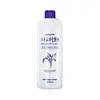What's inside
What's inside
 Key Ingredients
Key Ingredients

No key ingredients
 Benefits
Benefits

 Concerns
Concerns

 Ingredients Side-by-side
Ingredients Side-by-side

Dipotassium Glycyrrhizate
HumectantGlycerin
HumectantMyristic Acid
CleansingStearic Acid
CleansingPEG-7 Glyceryl Cocoate
EmulsifyingPotassium Hydroxide
BufferingLauric Acid
CleansingPalmitic Acid
EmollientGlyceryl Isostearate
EmollientGlyceryl Stearate Se
EmulsifyingDiallyldimethyl Ammonium Chloride
Glycol Distearate
EmollientCetearyl Alcohol
EmollientCoix Lacryma-Jobi Ma-Yuen Seed Extract
Skin ConditioningButylene Glycol
HumectantAloe Barbadensis Leaf Extract
EmollientPrunus Persica Leaf Extract
EmollientAlcohol Denat.
AntimicrobialSodium Hyaluronate
HumectantCetyl-Pg Hydroxyethyl Decanamide
Skin ConditioningCamellia Oleifera Leaf Extract
AstringentEDTA
Citric Acid
BufferingSodium Paraben
PreservativeParfum
MaskingDipotassium Glycyrrhizate, Glycerin, Myristic Acid, Stearic Acid, PEG-7 Glyceryl Cocoate, Potassium Hydroxide, Lauric Acid, Palmitic Acid, Glyceryl Isostearate, Glyceryl Stearate Se, Diallyldimethyl Ammonium Chloride, Glycol Distearate, Cetearyl Alcohol, Coix Lacryma-Jobi Ma-Yuen Seed Extract, Butylene Glycol, Aloe Barbadensis Leaf Extract, Prunus Persica Leaf Extract, Alcohol Denat., Sodium Hyaluronate, Cetyl-Pg Hydroxyethyl Decanamide, Camellia Oleifera Leaf Extract, EDTA, Citric Acid, Sodium Paraben, Parfum
 Reviews
Reviews

Ingredients Explained
These ingredients are found in both products.
Ingredients higher up in an ingredient list are typically present in a larger amount.
Butylene Glycol (or BG) is used within cosmetic products for a few different reasons:
Overall, Butylene Glycol is a safe and well-rounded ingredient that works well with other ingredients.
Though this ingredient works well with most skin types, some people with sensitive skin may experience a reaction such as allergic rashes, closed comedones, or itchiness.
Learn more about Butylene GlycolCitric Acid is an alpha hydroxy acid (AHA) naturally found in citrus fruits like oranges, lemons, and limes.
Like other AHAs, citric acid can exfoliate skin by breaking down the bonds that hold dead skin cells together. This helps reveal smoother and brighter skin underneath.
However, this exfoliating effect only happens at high concentrations (20%) which can be hard to find in cosmetic products.
Due to this, citric acid is usually included in small amounts as a pH adjuster. This helps keep products slightly more acidic and compatible with skin's natural pH.
In skincare formulas, citric acid can:
While it can provide some skin benefits, research shows lactic acid and glycolic acid are generally more effective and less irritating exfoliants.
Most citric acid used in skincare today is made by fermenting sugars (usually from molasses). This synthetic version is identical to the natural citrus form but easier to stabilize and use in formulations.
Read more about some other popular AHA's here:
Learn more about Citric AcidYou might know this plant as Job's Tears or Chinese pearl barley. It is a grain native to Southeast Asia.
This ingredient has skin conditioning properties. Emerging studies show the grain to exhibit antioxidant and anti-inflammation properties as well. (With one study finding this ingredient to be effective at blocking melanin when skin is exposed to UV).
Job's tears is rich in nutrients, such as thiamine, riboflavin, niacin and ascorbic acid.
You can also find great antioxidants such as ferulic acid, caffeic acid.
To top if off, ceramides are also present in this grain.
Learn more about Coix Lacryma-Jobi Ma-Yuen Seed ExtractDipotassium Glycyrrhizate comes from licorice root.
Extracts of licorice have demonstrated to have antibacterial, anti‐inflammatory, antiviral, antioxidant properties.
One component, glabridin, has extra potent antioxidant and soothing properties. It has also been found to block pigmentation from UVB rays in guinea pigs.
Licorice Root also contains a flavonoid. Flavonoids are a natural substance from in plants. Flavonoids also have antioxidant properties.
Another component, glycyrrhizin, has been found to have anti-inflammatory and antimicrobial benefits. This may make licorice root extract effective at treating acne. However, more research is needed to support this.
Liquiritin is one of the flavone compounds found in licorice. It has been found to help lighten skin by preventing tyrosinase from reacting with tyrosine. When the two react, protein is converted to melanin. Melanin is the substance in your body that gives your features pigmentation.
Licorice root is native to Southern Europe and Asia. It has been used in traditional Chinese medicine to help with respiratory issues.
Learn more about Dipotassium GlycyrrhizateGlycerin is already naturally found in your skin. It helps moisturize and protect your skin.
A study from 2016 found glycerin to be more effective as a humectant than AHAs and hyaluronic acid.
As a humectant, it helps the skin stay hydrated by pulling moisture to your skin. The low molecular weight of glycerin allows it to pull moisture into the deeper layers of your skin.
Hydrated skin improves your skin barrier; Your skin barrier helps protect against irritants and bacteria.
Glycerin has also been found to have antimicrobial and antiviral properties. Due to these properties, glycerin is often used in wound and burn treatments.
In cosmetics, glycerin is usually derived from plants such as soybean or palm. However, it can also be sourced from animals, such as tallow or animal fat.
This ingredient is organic, colorless, odorless, and non-toxic.
Glycerin is the name for this ingredient in American English. British English uses Glycerol/Glycerine.
Learn more about Glycerin